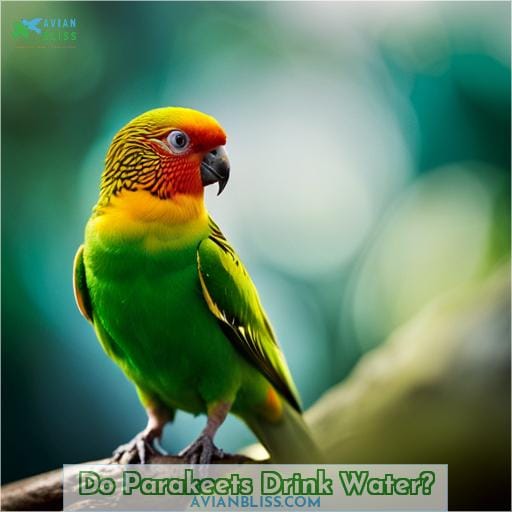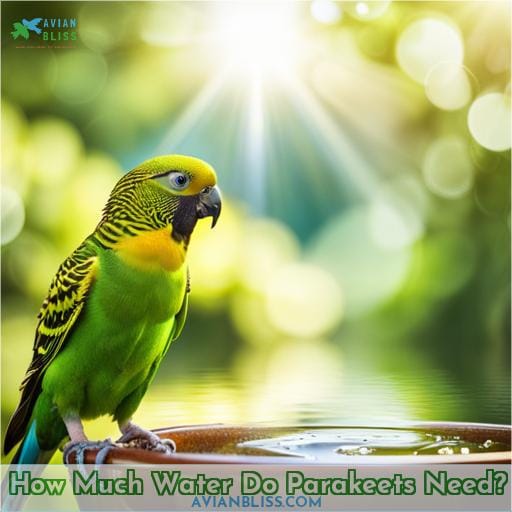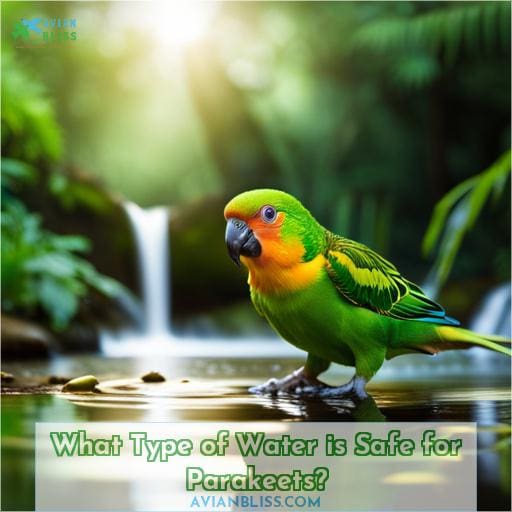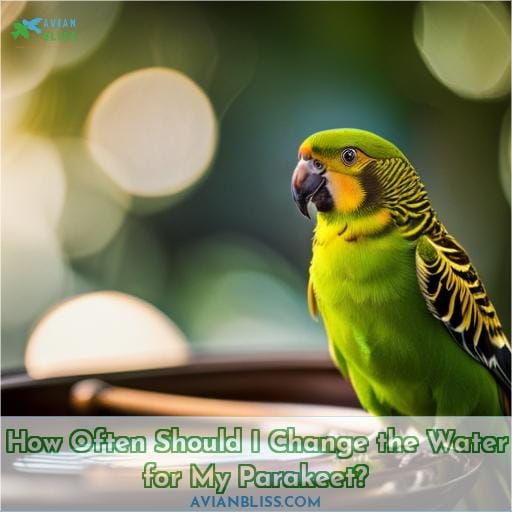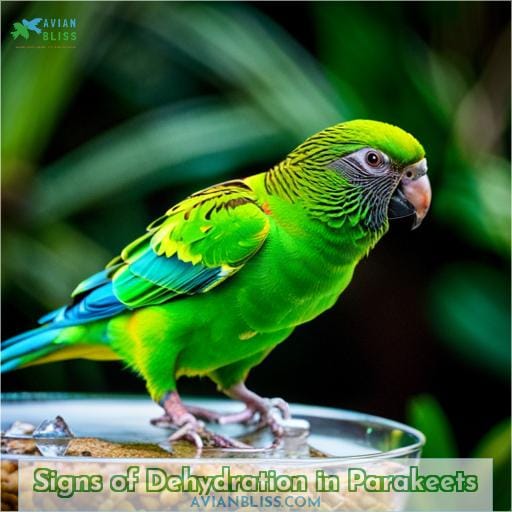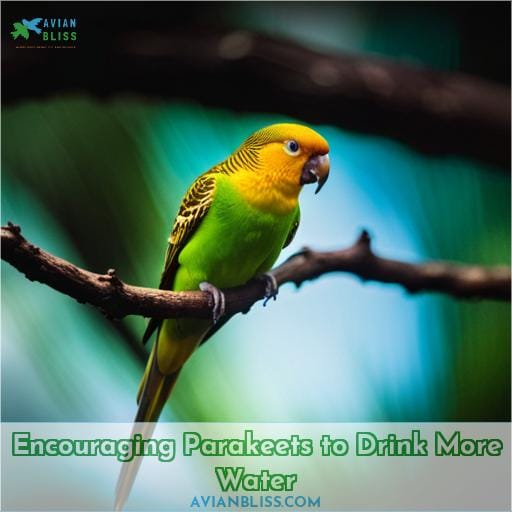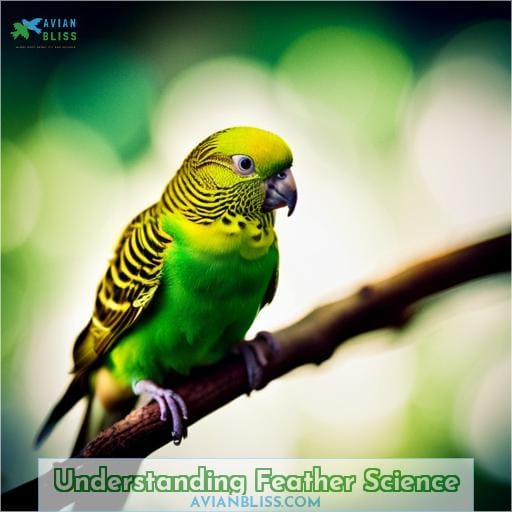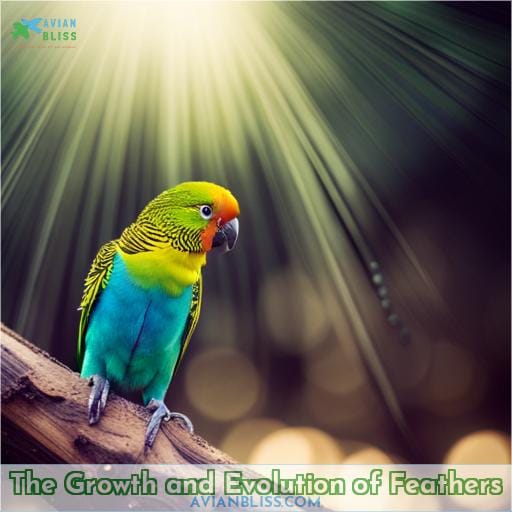This site is supported by our readers. We may earn a commission, at no cost to you, if you purchase through links.
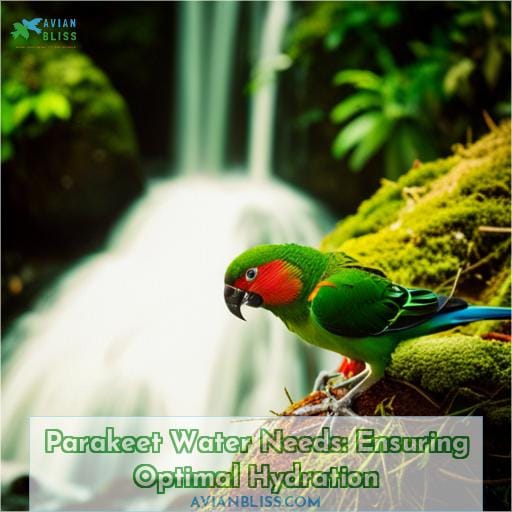 Tired of constantly refilling your parakeet’s water bowl? Worried about their hydration levels? Look no further! This article will guide you through all the essential information on parakeet water needs, ensuring optimal hydration for your feathered friend.
Tired of constantly refilling your parakeet’s water bowl? Worried about their hydration levels? Look no further! This article will guide you through all the essential information on parakeet water needs, ensuring optimal hydration for your feathered friend.
Discover how much water they need, what type is safe for them, and how often to change it. Say goodbye to dehydration worries and provide your parakeet with the best care possible.
Table Of Contents
- Key Takeaways
- Do Parakeets Drink Water?
- How Much Water Do Parakeets Need?
- What Type of Water is Safe for Parakeets?
- How Often Should I Change the Water for My Parakeet?
- Signs of Dehydration in Parakeets
- Encouraging Parakeets to Drink More Water
- Understanding Feather Science
- The Anatomy of Feathers
- The Function of Feathers
- The Growth and Evolution of Feathers
- Frequently Asked Questions (FAQs)
- Conclusion
Key Takeaways
- Parakeets should have access to clean water sources at all times to ensure easy access.
- Tap water, especially filtered city supply, is generally safe for parakeets to drink.
- Changing the water daily is crucial to prevent bacterial growth and maintain cleanliness.
- Recognizing signs of dehydration in parakeets is important for their overall well-being and health.
Do Parakeets Drink Water?
Yes, parakeets do drink water regularly to stay hydrated. Water consumption is essential for their overall health and well-being.
Parakeets have specific water needs that must be met to ensure optimal hydration. They typically need to drink water 2-3 times a day, which amounts to about 5% of their body weight in water intake. On average, they’ll consume about a teaspoon of water per day depending on factors such as exercise level and environmental conditions.
It’s important to provide clean and fresh drinking water for your parakeet on a daily basis. Offering them access to multiple sources of clean drinking water can help ensure they always have easy access when needed.
Tapwater is generally safe for parakeets, especially if it comes from the city’s filtered supply; however, it’s crucial not to use well-water containing hard metals or consider using de-ionized or bottled waters instead.
How Much Water Do Parakeets Need?
To ensure your parakeet stays properly hydrated, it’s important to understand how much water they need on a daily basis.
Here are the key points to keep in mind:
- Parakeets need to drink water 2-3 times a day or about 5% of their body weight.
- On average, they’ll drink about a teaspoon of water a day overall, depending on their exercise level and other activities going on around them.
- Offering them water in more than one place is a good option to ensure they always have access.
It’s crucial for parakeets’ health that they receive adequate hydration each day as dehydration can lead to various symptoms such as discolored feathers, dry mouth, sunken eyes, fatigue, and lack of energy.
Make sure you provide clean tap water or filtered city tap water for your bird and change it every day along with cleaning the bowl regularly from any debris that may fall into it.
What Type of Water is Safe for Parakeets?
What type of water is safe for your parakeet to drink?
When it comes to providing water for your feathered friend, it’s important to ensure that the water is clean and free from any harmful substances.
Tap water can be perfectly fine, especially if it has been filtered by the city water department. However, if you have well water with hard metals or other contaminants, using a filter or opting for de-ionized or bottled water may be a better choice.
To prevent dehydration in your parakeet, make sure to change their drinking bowl daily and clean any debris that falls into the bowl. Offering multiple sources of fresh and clean drinking options can also ensure constant access to hydration.
Avoid flavored waters or those with added vitamins as they may not be healthy for your bird and could encourage bacterial growth in their bowl.
How Often Should I Change the Water for My Parakeet?
Changing the water for your parakeet should be done on a daily basis to ensure optimal hydration and prevent dehydration.
- Water cleanliness: By changing the water daily, you can maintain its cleanliness and prevent any bacteria growth that may harm your parakeet’s health.
- Hydration habits: Parakeets need access to fresh, clean water throughout the day to meet their hydration needs. Changing the water regularly encourages healthy drinking habits.
- Preventing dehydration: Dehydration can have serious consequences for your parakeet’s well-being. By providing them with fresh water every day, you help them stay hydrated and avoid potential health issues.
- Changing routine: Consistency is key when it comes to caring for your parakeet’s needs.Incorporating regular changes in their watering routine helps establish good hygiene practices while ensuring they always have access to clean drinking sources.
Signs of Dehydration in Parakeets
Now that you know how often to change the water for your parakeet, it’s important to be aware of the signs of dehydration in these birds. Dehydration can have serious consequences on their health and well-being, so it’s crucial to recognize the symptoms early on.
Here are some common indicators that your parakeet may be dehydrated:
| Signs of Dehydration | Description |
|---|---|
| Feathers become discolored | Discoloration or dullness in feather appearance |
| Dry mouth | Lack of moisture around the bird’s beak and throat |
| Eyes become sunken | Eyes appear smaller or deeper set than usual |
| Unusual dropping consistency | Changes in color, texture, or frequency of droppings |
| Mental fatigue | Decreased alertness or responsiveness |
If you notice any behavioral changes such as decreased energy levels, a change in attitude towards food and water consumption, or decrease in chirping activity; these could also indicate potential hydration issues.
It’s essential to take preventive measures by ensuring proper hydration habits for your parakeets. This includes providing fresh clean water daily and monitoring its quality regularly. Additionally, offering multiple sources for drinking water can help ensure easy access at all times.
By being vigilant about your parakeet’s hydration needs and recognizing signs of dehydration early on,
you can help maintain optimal feather health
and overall well-being.
Encouraging Parakeets to Drink More Water
To ensure optimal hydration for your parakeet, it’s important to encourage them to drink more water.
- Water Flavoring:
- Adding a teaspoon of fresh fruit juice or honey to their water can make it more appealing and enticing for your parakeet.
- Hydration Tips:
- Offer multiple sources of water throughout their cage, such as bowls or hanging bottles, so that they always have easy access to clean drinking water.
- Behavioral Approaches:
- Train your parakeet to associate drinking with positive reinforcement by offering treats or praise when they take a sip from their water source.
By incorporating these creative watering techniques and considering environmental influences, you can encourage your parakeet’s natural instinct for hydration while ensuring that they stay properly hydrated in order maintain optimal health.
Understanding Feather Science
Feathers play a crucial role in the lives of parakeets, as they provide various functions and have evolved over time. Understanding feather science is essential for anyone with extensive training and expertise in animal health, nutrition, and care.
Feather evolution has led to the development of avian plumage that serves multiple purposes.
To delve deeper into this topic, let’s explore some key aspects of feather functionality:
| Feathers | Function |
|---|---|
| Flight feathers | Enable birds to fly by providing lift and control |
| Display feathers | Used for courtship rituals or territorial displays |
| Insulation feathers | Help regulate body temperature by trapping air close to the skin |
| Weatherproofing feathers | Keep birds dry during rain or water activities |
| Still a Mystery | There are still unanswered questions about certain types of feathers. |
By asking Tinbergen’s questions – how do feathers work? What do they do? How do they develop? And how did they evolve?, scientists study feather science using an integrated approach across biological disciplines.
This interdisciplinary research allows us to better understand these incredible structures that contribute so significantly to a parakeet’s life.
The Anatomy of Feathers
As an expert in animal health and care, you understand the importance of providing optimal hydration for your parakeet. Now, let’s delve into the fascinating world of feathers to better comprehend their structure, types, and how they contribute to a bird’s overall well-being.
By understanding the anatomy of feathers, you can ensure that your parakeet has everything it needs to thrive and maintain its health.
Feather Structure
To understand the anatomy of feathers in parakeets, you need to know that:
- Each feather is composed of a central rachis and barbs that interlock to form a smooth surface.
- Feather development offers evolutionary insights into their functionality.
- Feathers play crucial roles in flight, insulation, display, and camouflage.
The mysteries of avian plumage continue to fascinate scientists as they unravel the secrets behind these remarkable structures.
Feather Types
As you explore the anatomy of parakeets, it’s important to understand the different types of feathers that make up their plumage.
Feather evolution has resulted in a wide range of feather structures, contributing to the plumage diversity and avian adornments seen in these birds.
Feathers enable parakeets to engage in feathered flight and play a crucial role in display dynamics within their social interactions.
Further Learning
By delving into the anatomy of feathers, you can gain a deeper understanding of how these intricate structures contribute to the remarkable abilities and characteristics displayed by parakeets.
Learning about bird bathing and incorporating hydration tips into your parakeet’s routine are healthy habits that ensure optimal water intake.
Additionally, exploring feather evolution sheds light on the fascinating development and function of these unique appendages.
Understanding the importance of water quality is crucial for maintaining your parakeet’s overall well-being.
The Function of Feathers
As an expert in animal health and care, you understand the importance of feathers for parakeets.
Feathers serve multiple functions, including flight, display, insulation, weatherproofing, and even some mysteries that are yet to be fully understood.
These remarkable structures allow parakeets to fly gracefully through the air while also providing them with protection from the elements and enhancing their ability to communicate through displays.
Understanding how feathers function is crucial in ensuring optimal health and well-being for your feathered friend.
Flight
Feathers play a crucial role in enabling your parakeet to take flight and explore its surroundings. They’ve evolved over time to serve various functions, including providing lift and stability during avian flight.
- Feathers allow for the freedom of soaring through the skies.
- They give your parakeet a sense of power as they navigate their environment.
- Understanding feather anatomy helps us appreciate the intricacies of their flight capabilities.
- Feather growth is a fascinating process that contributes to the beauty and functionality of these remarkable creatures.
Display
Feathers play a crucial role in your parakeet’s display behaviors.
They aren’t just for flight and insulation, but also serve as avian adornments, showcasing winged artistry with their plumage patterns and feathered elegance.
| Feather Evolution | Avian Adornments | Winged Artistry |
|---|---|---|
| Plumage Patterns | Feathered Elegance |
Insulation
To keep your parakeet warm and protected from the elements, their feathers serve as a natural insulation barrier.
Feather evolution has led to plumage adaptations that provide thermal regulation and avian insulation through feather growth.
Weatherproofing
Keeping your parakeet’s feathers in good condition is essential for weatherproofing their body.
Their waterproofing feathers provide moisture protection, with hydrophobic plumage that’s rain resistant and provides feather water resistance.
Still a Mystery
Despite extensive research, the exact function of feathers in parakeets still remains a mystery to scientists.
Understanding their role in hydration challenges, water preferences, and evolutionary enigma continues to elude experts.
The Growth and Evolution of Feathers
As we continue our exploration of parakeet feathers and their functions, let’s delve into the fascinating topic of the growth and evolution of these unique structures.
Feather evolution is a remarkable process that has resulted in the stunning avian adornments we see today. Feathers have undergone plumage progression over millions of years, with ancient dinosaurs sporting primitive feather-like structures known as dinosaur plumes.
Through winged transformations, feathers gradually developed into complex interlocking structures capable of supporting flight.
Scientists use an integrated approach to study feather development and evolution, asking questions about how they work, what they do, how they develop, and their evolutionary origins. This extensive training allows them to uncover new insights into this captivating aspect of bird biology.
By understanding the growth and evolution of feathers in parakeets and other birds species alike; we gain a deeper appreciation for these incredible adaptations that play crucial roles in flight performance, display behavior, camouflage, and insulation from elements.
Frequently Asked Questions (FAQs)
Can parakeets drink flavored water?
Yes, parakeets can drink flavored water in moderation. However, it’s important to ensure that the flavoring is natural and free from preservatives or added sugars. Consult with a veterinarian for specific guidance on your parakeet’s dietary needs.
How often should I clean my parakeet’s water bowl?
To ensure your parakeet stays healthy, clean their water bowl daily.
Remove any feathers, droppings, or food particles that may have fallen into the water.
Regular cleaning prevents bacteria growth and keeps the water fresh for your bird to drink.
What are the signs of dehydration in parakeets?
Dehydration in parakeets can lead to:
- Discolored feathers
- Dry mouth
- Sunken eyes
- Unusual droppings
- Fatigue
- And more.
To prevent this, provide clean water daily and monitor their intake for any changes that may signal illness or stress.
How can I encourage my parakeet to drink more water?
To encourage your parakeet to drink more water, offer clean water daily and consider adding:
- A teaspoon of fresh fruit juice or honey (no preservatives or added sugars) to a pint of water.
- Flavoring the water can make it more enticing for your feathered friend.
How do feathers evolve and grow in parakeets?
To understand how feathers evolve and grow in parakeets, envision a miraculous transformation. Feathers, like nature’s artistry, gradually develop from simple tufts into interlocking structures capable of supporting flight and captivating displays.
Conclusion
To ensure optimal hydration for your parakeet, it’s important to understand their water needs.
Providing fresh, clean water is essential, and changing it regularly is crucial to prevent dehydration.
By monitoring signs of dehydration and encouraging your parakeet to drink more water, you can help maintain their health and well-being.
By following these guidelines, you can ensure your parakeet stays hydrated and happy.

